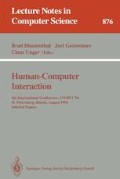Abstract
This paper describes a hypertext system called System of Meaning Integrities structural Creation (SMIsC). The central component of this system is the macrocontrol subsystem. Its purpose is to overcome the Navigation Problem in hypertext by assisting users to blaze semantically coherent trails. These semantically coherent trails are meaning integrities. To construct the subsystem, we used discourse analysis and psycholinguistics and this is explained in detail in our previous paper [3]. The present paper deals with other aspects of SMIsC. Although not the central component, these other aspects of the system directly contribute to the general “coherentist” (holistic) orientation of SMIsC. We discuss the working of the micro level of the database network with respect to newly incoming nodes and links. We also discuss the monitoring of the emergence of large coherence clusters at the macro level in the network. We emphasize the close analogy between these events and the self-creation of meaning in synergetics [7]. Harvesting coherence is described as “catching” the clusters in the network for using them as global navigational contexts and a source of grounding materials and goal structures.
Preview
Unable to display preview. Download preview PDF.
References
P.A. Carlson: Square books and round books: cognitive implications of hypertext. Academic Computing, April 1990, 16–19, 26–31.
P.A. Carlson: Virtual text and new habits of mind. In: H. Maurer, ed., New results and new trends in computer science; Lecture Notes in Computer Science, Vol. 555. Berlin: Springer-Verlag, 1991; 25–53.
V.M. Chelnokov, V.L. Zephyrova: Coherent navigation in hypertext environments: the SMIsC conception. In: L. J. Bass, J. Gornostaev and C. Unger, eds., Human-computer interaction (EWHCI'93 selected papers); Lecture Notes in Computer Science, Vol. 753. Berlin: Springer-Verlag, 1993; 298–317.
N. Christofides: Graph theory: an algorithmic approach. New York: Academic Press, 1975.
J. Conklin: Hypertext: an introduction and survey. IEEE Computer, 20(9), 1987, 17–41.
T.A. van Dijk, W. Kintsch: Strategies of discourse comprehension. New York: Academic Press, 1983.
H. Haken: Information and self-organization: a macroscopic approach to complex systems. Berlin: Springer-Verlag, 1988.
C.H. Holman, W. Harman: A handbook to literature (6th ed.). New York: Macmillan, 1992.
M.R. Kibby, J.T. Mayes: Towards intelligent hypertext. In: R. McAleese, ed., Hypertext: theory into practice. Norwood, NJ: Ablex, 1989; 164–172.
W. Kintsch, T.A. van Dijk: Towards a model of text comprehension and production. Psychological Review, 85(5), 1978, 363–394.
A.R. Lacey: A dictionary of philosophy. London: Routledge and Kegan Paul, 1979.
K. Lehrer: Knowledge. Oxford: Oxford University Press, 1978.
W.J.M. Levelt: The speaker's linearization problem. Philosophical Transactions of the Royal Society of London, B-295(1077), 1981, 305–314.
W.J.M. Levelt: Linearization in describing spatial networks. In: S. Peters and E. Saarinen, eds., Processes, beliefs, and questions. Dordrecht: D. Reidel, 1982; 199–220.
P.C. Murray: Documentation goes digital. BYTE, 18(10), September 1993, 121–129.
I. Prigogine, P.M. Allen, R. Herman: Long term trends and the evolution of complexity. In: E. Laszlo and J. Bierman, eds., Goals in global community (A report to the Club of Rome), Vol. 1. New York: Pergamon Press, 1977; 1–63.
R. Rada, M. Mhashi, J. Barlow: Hierarchical semantic nets support retrieving and generating hypertext. Information and Decision Technologies, 16(2), 1990, 117–135.
K. Ray, J.R. Driscoll: New directions for microcomputer-based hypertext systems. DATABASE, August 1990, 60–64.
C.F. Reynolds, J. Robertson: Navigation requirements in large hypertext systems. Journal of Document&Text Management, 1(1), 1993, 7–23.
R. Siiter: Associationism. In: The encyclopedic dictionary of psychology (4th ed.). Guilford, CT: The Dushkin Publishing Group, Inc., 1991.
Author information
Authors and Affiliations
Editor information
Rights and permissions
Copyright information
© 1994 Springer-Verlag Berlin Heidelberg
About this paper
Cite this paper
Chelnokov, V.M., Zephyrova, V.L. (1994). Cultivating and harvesting semantic coherence in SMIsC hypertext networks. In: Blumenthal, B., Gornostaev, J., Unger, C. (eds) Human-Computer Interaction. EWHCI 1994. Lecture Notes in Computer Science, vol 876. Springer, Berlin, Heidelberg. https://doi.org/10.1007/3-540-58648-2_39
Download citation
DOI: https://doi.org/10.1007/3-540-58648-2_39
Published:
Publisher Name: Springer, Berlin, Heidelberg
Print ISBN: 978-3-540-58648-7
Online ISBN: 978-3-540-49036-4
eBook Packages: Springer Book Archive

